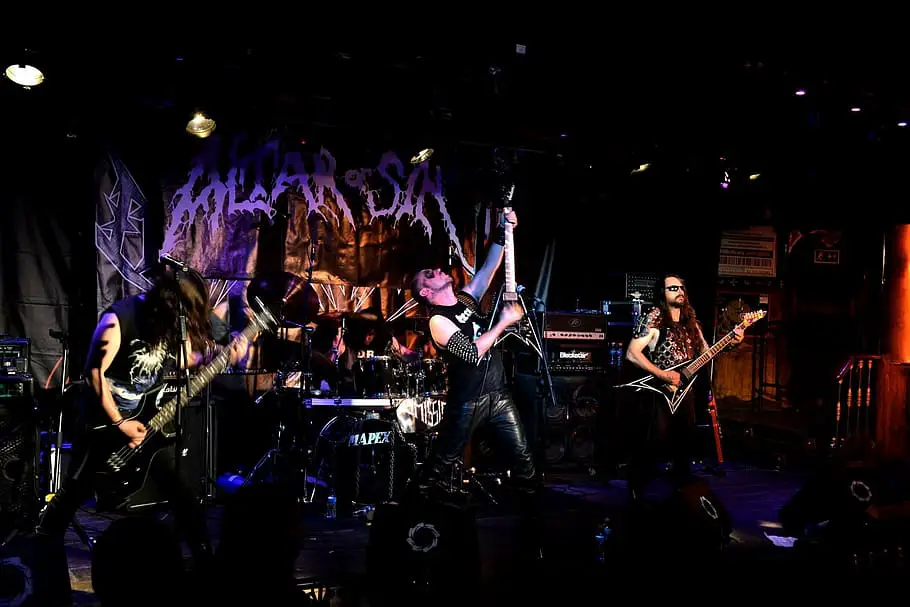Metal music has evolved a lot since the 1970s when it was created. Since the 1980s, it has dwelt in mainstream music and has defined the music industry. And every time you thought it was over for metal, another sub-genre came out of nowhere and became twice as popular. It seems like it’s the only guitar-oriented music genre alive and kicking today.
Luckily for guitarists all around the globe, there is an active metal scene for everyone, so no matter if you’re looking for virtuoso licks or powerful earth-trembling riffs, you can find your cup of tea… or pint of beer!
What is Hard Rock?
Hard rock music derived from British blues. It relies heavily on guitar parts with pentatonic scales. Also, the use of overdrive and distortion effects is not applied only to guitars, but the bass and even keyboards sometimes. Some of the first guitar heroes (e.g. Ritchie Blackmore) derived from this genre.
The word “hard” describes the extra energy it has compared to the typical rock genre. Guitars, drums, vocals, and everything else is set very loud and close to cracking. Some of the most famous hard rock performers are Kiss, Deep Purple, AC/DC Aerosmith, and Guns N’ Roses.

What is Heavy Metal?
The phrase “heavy metal” describes music that is more than hard rock. Faster and more energetic, some of the best guitar solos in music’s history came from this genre.
Many bands had two or even three guitarists and the key focus was all about intense high-pitch playing and singing as loudly as possible. It stayed in the mainstream so long that many metal genres derived directly from it.
Black Sabbath is often cited as the first heavy metal band, but the most famous heavy metal bands come from the UK – Judas Priest and Iron Maiden.

What is Death Metal?
There came the time when someone decided to give even more than heavy metal. Everything went to the extremes–guitars dropped their tuning, riffs became even more technically demanding, distortion effects were so present that even vocals became screaming and growling instead of singing.
Drums followed the same routine and created a constant noise coming from double bass and blast beats. This genre is all about fast-paced rhythms and the lyrics can be very gore and maleficent. Cannibal Corpse, Morbid Angel, Nile, and Arch Enemy are just some of the most famous death metal bands out there.

There are so many genres inside metal music that we could write a novel about each one individually and publish them all together as a book. But, for this occasion, we’re going to focus on the basics and track how different the guitar role can be.
Heavy Metal
As already said, everything started with this genre and officially began with UK bands. Their impact on other genres is so significant that even the visual appearance of black leather and wristbands with spikes was taken from it.
The best heavy metal songs tend to have an anthemic mid-tempo vibe and guitars play riffs and themes equally. Guitars sound slightly heavier than in the hard rock genre. During themes and solo parts, guitarists may play together, creating wonderful two-voice unison melodies often sung along by the audience.
Thrash Metal
This was the first extreme metal genre that became equally popular in the U.S.A. and Europe. It mixes hardcore punk speed elements with traditional heavy metal. That’s why the vocals are mostly in the form of shouting or aggressive singing. They also heavily rely on open strings, power chord techniques, and tremolo picking.
Solo guitar parts usually consist of playing as fast as you can and creating more noise than melody. The overall sound is extreme and noisy, thanks to hi-gain guitar amps turned to the max. A lot of attention is given to visual appearance, so denim vests with patches became one of the genre’s trademarks.

Progressive Metal
It could be also called progressive rock on steroids. It’s kinda the same as what heavy metal achieved with hard rock. Most famous bands are from the U.S.A., but they are widely accepted all around the world.
This is one of the most technically advanced metal genres, and every music player in this genre is considered a virtuoso. In this genre, every instrument takes the role of the lead instrument and it’s not rare that even keyboards perform solo parts with a sound similar to the lead guitar.
Odd time-signatures, sudden drops, complex drum patterns or tempo changes, numerous song parts, and songs that last longer than ten minutes are just some of the usual trademarks of this genre. The guitar sound is very clear and precise and is present not just in clean and distorted sounds, but in acoustic or eight-string guitars, as well.
Power (Neoclassical) Metal
This genre is very popular in Europe and South America. You will recognize it for using a lot of symphonic instruments and keyboards in their songs. They are prone to create lyrics dedicated to some fantasy world or record concept albums that include actors, just like in regular opera (e.g. Avantasia).
Guitars often play tunes similar to classical music and even include Vivaldi or Mozart pieces in their songs. Songs are usually upbeat and very fast-paced with rhythm guitars playing fast picking riffs, while solo parts are usually very melodic with a lot of arpeggios, tapping, and sweep picking techniques. Guitars are usually distorted with minor use of a clean sound.
Groove Metal
This genre derives from thrash metal but focuses on playing more mid-tempo and on impact instead of speed. Guitars drop in tune, mostly playing heavy syncopated and catchy riffs while vocals can either be sung aggressively or screaming and growling. Solo guitars are present but they are no match to lead guitarists in other genres.
Death Metal
Death metal originates from the U.S.A. It is considered the most extreme genre of metal music. There is a lot of tremolo picking and palm muting inside of these genres and they tend toward atonal song structure.
Creating a sudden burst of noise with growl vocals is what this genre is most famous for. But to cause confusion, subgenres, like melodic death metal are the other side of the coin with a lot of heavy metal influence, while technical death metal leans toward progressive metal. Guitars are tuned lower than standard, are extremely distorted and sometimes even fuzzed while using seven-stringed guitars.

Black Metal
This is another metal genre which comes from Europe. It can be very melodic and even use classical symphonic elements or can be very aggressive and fast-paced with guitars playing mostly unmuted, distorted tremolo picking and dissonant riffs to resemble wrath and chaos. Vocals are mostly screaming while solo guitars are not overly remarkable.
They focus more on building a grim atmosphere with their lyrics and pay a lot of attention to visual appearance, often wearing corpse paint or war paint with special costumes and black leather armbands with spikes. Based on the subgenre, production can be literally either underground lo-fi or state-of-the-art.
Nu Metal
Nu metal derives from alternative metal and went further by combining groove metal music with hip hop, grunge, or industrial music. Some of the bands even include a DJ in their line-ups and is also one of the genres where the guitar solo is usually omitted in the song.
Guitars are tuned down a lot, focusing on mid-paced songs with heavy riffs and sudden breaks. They are also pioneers of using seven-string guitars regularly while their singers usually scream and shout or even rap instead of regular singing. It’s no wonder that many metal fans don’t recognize this genre as part of metal because, other than guitar parts, nothing really resembles traditional metal.
Metalcore
The metalcore genre can be described in short as metal meets hardcore and was invented in the U.S.A. But, to be precise, imagine melodic death metal riffs mixed with clean vocals that may even resemble pop music mixed with hardcore elements such as scream and sudden breaks and drops. Songs are usually fast-paced while guitars are mostly riff-oriented with solo parts that can resemble heavy, power, and thrash metal solo guitars.

Conclusion
Even if this article was twice as long, we still couldn’t name all the important genres, so we’ll have to leave glam, gothic, doom, speed, stoner, folk, avant-garde, industrial, and other metal genres for the next time.
We hope you’re now aware that metal music is a lot more than Metallica. It has come a long way from hard rock and is the only rock genre that still continues to evolve. The most important fact that separates it from the others is the loyalty of their fans that can only be matched by the Woodstock movement.